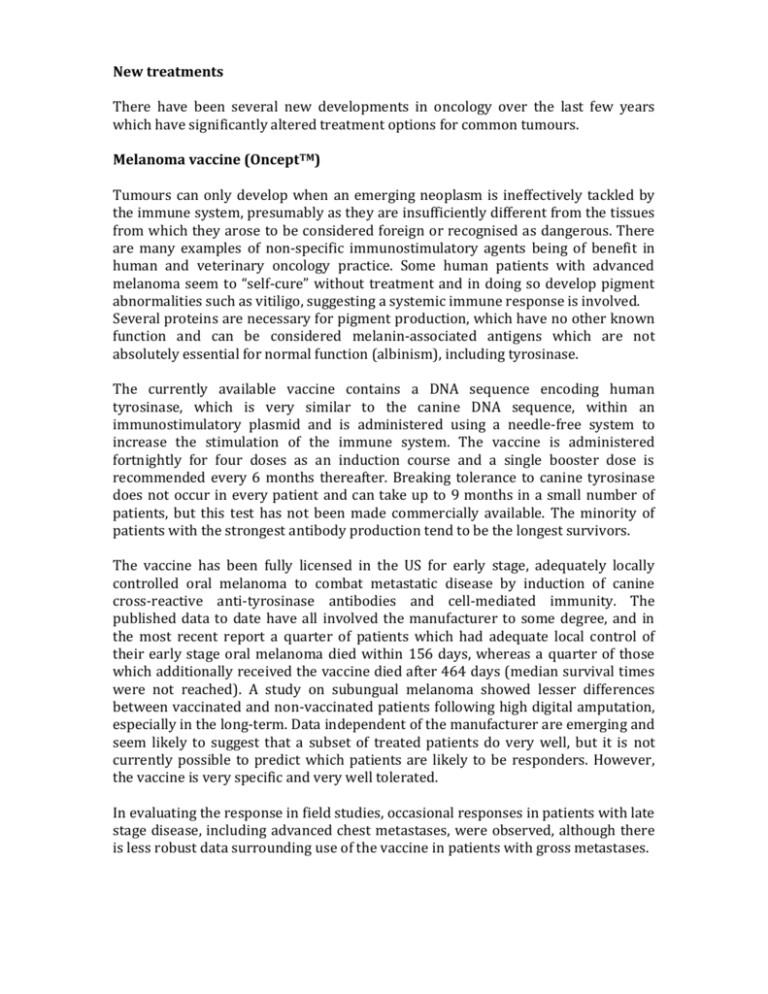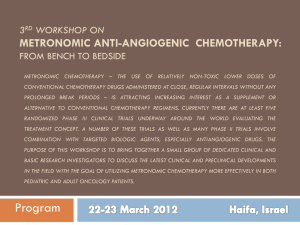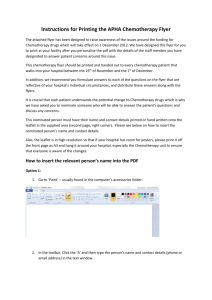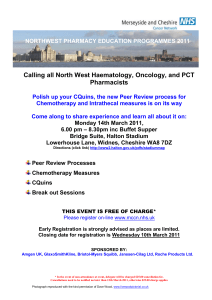New treatments There have been several new developments in
advertisement

New treatments There have been several new developments in oncology over the last few years which have significantly altered treatment options for common tumours. Melanoma vaccine (OnceptTM) Tumours can only develop when an emerging neoplasm is ineffectively tackled by the immune system, presumably as they are insufficiently different from the tissues from which they arose to be considered foreign or recognised as dangerous. There are many examples of non-specific immunostimulatory agents being of benefit in human and veterinary oncology practice. Some human patients with advanced melanoma seem to “self-cure” without treatment and in doing so develop pigment abnormalities such as vitiligo, suggesting a systemic immune response is involved. Several proteins are necessary for pigment production, which have no other known function and can be considered melanin-associated antigens which are not absolutely essential for normal function (albinism), including tyrosinase. The currently available vaccine contains a DNA sequence encoding human tyrosinase, which is very similar to the canine DNA sequence, within an immunostimulatory plasmid and is administered using a needle-free system to increase the stimulation of the immune system. The vaccine is administered fortnightly for four doses as an induction course and a single booster dose is recommended every 6 months thereafter. Breaking tolerance to canine tyrosinase does not occur in every patient and can take up to 9 months in a small number of patients, but this test has not been made commercially available. The minority of patients with the strongest antibody production tend to be the longest survivors. The vaccine has been fully licensed in the US for early stage, adequately locally controlled oral melanoma to combat metastatic disease by induction of canine cross-reactive anti-tyrosinase antibodies and cell-mediated immunity. The published data to date have all involved the manufacturer to some degree, and in the most recent report a quarter of patients which had adequate local control of their early stage oral melanoma died within 156 days, whereas a quarter of those which additionally received the vaccine died after 464 days (median survival times were not reached). A study on subungual melanoma showed lesser differences between vaccinated and non-vaccinated patients following high digital amputation, especially in the long-term. Data independent of the manufacturer are emerging and seem likely to suggest that a subset of treated patients do very well, but it is not currently possible to predict which patients are likely to be responders. However, the vaccine is very specific and very well tolerated. In evaluating the response in field studies, occasional responses in patients with late stage disease, including advanced chest metastases, were observed, although there is less robust data surrounding use of the vaccine in patients with gross metastases. Metronomic chemotherapy In addition to evasion of the immune system, for a tumour to grow beyond ~2mm in size, provision of oxygen, energy and a method of waste disposal requires new blood vessel formation, a process called neoangiogenesis. Induction of neoangiogenesis is another hallmark of cancer development. Opposition of neoangiogenesis is only one aspect of metronomic chemotherapy. Endothelial cells, like many tumour cells are sensitive to traditional “maximum tolerated dose” chemotherapy, and like tumour, bone marrow, gut lining and other tissues, endothelia recover in the intervals between chemotherapy doses. However, compared to other tissues, endothelia are exquisitely sensitive to low doses of chemotherapy, especially when there are no breaks between chemotherapy doses. Metronomic chemotherapy exploits this sensitivity. Tumour cells can be inherently resistant to chemotherapy, or can acquire further mutations to develop resistance to initially effective chemotherapy. Endothelia are reliably sensitive to metronomic chemotherapy and have a stable genome, so do not develop resistance like tumours. However, well established blood vessels do not regress on anti-angiogenic therapy and in many cases stable disease or retardation of progression is the best response which can be achieved with antiangiogenic chemotherapy. Some clients have difficulty in abandoning attempts to target tumour cells directly and switching the target to neoangiogenesis. Other aspects of metronomic chemotherapy beyond angiogenesis include immune system modulation. Low dose alkylator therapy with or without nSAIDs has been shown to downregulate the number and function of regulatory T cells (formerly known as suppressor T cells). Compared to patients with incompletely excised subcutaneous soft tissue sarcomas without further treatment which tended to relapse around 211 days after surgery (median), the addition of daily piroxicam and low dose cyclophosphamide delayed relapse to more than 400 days. Splenic haemangiosarcoma patients treated with low dose cyclophosphamide, piroxicam and etoposide post-splenectomy had a comparable survival to those patients treated with doxorubicin. Additionally, there have been some responses in patients with metastatic sarcomas. Chlorambucil and lomustine have been assessed in a few papers, but most involve cyclophosphamide (10-15-25 mg/m2 p/o q24h), which requires recompounding at a specialist pharmacy for even the largest dogs. Calculating how many days of therapy would be covered by a single 50 mg tablet as is common practice with maximum tolerated dose chemotherapy protocols is completely at odds with a metronomic approach. Side effects occur in up to 40% of cases, but are generally mild. Similar to the use of maximum tolerated dose chemotherapy, there is a 10-22% risk of sterile haemorrhagic cystitis in metronomic cyclophosphamide-treated patients. However, most of these cases have microscopic haematuria documented on scheduled monitoring, rather than clinically significant cystitis and many of these respond to switching to an every other day metronomic regimen. However, the impact on the benefit of an every other day protocol is largely unknown. With any alkylator, long term therapy might result in myelosuppression, especially with thrombocytopenia. At present, it is not possible to assess how completely neoangiogenesis or the suppressant effects of regulatory T cells are inhibited by these protocols. Receptor tyrosine kinase inhibitor (RTKi) therapy Several growth factor receptors are present on the surface of cells, and influence cytoplasmic processes through signalling which starts with activation of the tyrosine kinase domain of receptors when they bind their growth factors. The effect of activation is often enhanced proliferation, survival, and resistance to several therapies, hence their role in carcinogenesis. One such receptor is Kit, which is a receptor found on all early bone marrow haematopoietic cells, but it persists in mast cells throughout their development and maturation. Kit is also found on the interstitial cells of Cajal (the pacemakers of the gut), melanocytes and germ cells. Similar to the metronomic approach, some RTKis have been shown to suppress regulatory T cell number and function. A couple of products have been licensed throughout the EU. Toceranib (“Palladia”, Pfizer) targets Kit, PDGFR, VEGFR, Flt-1 and other receptors. Masitinib (“Masivet”, AB Science) is more selective and targets Kit and PDGFR. Both are licensed for the treatment of intermediately and poorly differentiated, inoperable, metastatic or recurrent mast cell tumours, in the case of masitinib with the proviso that they express a kit mutation. For both drugs, better responses are seen in tumours with kit mutations, but expression of normal kit does not preclude a response. Toceranib studies have shown responses in 43% of mast cell tumours, with stable disease in a further 17% of cases for between 12 and 18 weeks. Masitinib studies have mainly focussed on stable disease although responses (in 16% of cases) are observed too. The response at 6 months of therapy is said to be predictive of the longer term response with masitinib. Beyond mast cell tumours, RTKis have been used with several other tumour types, such as anal sac apocrine gland adenocarcinomas, osteosarcoma, lymphoma, thyroid carcinoma, squamous cell carcinoma, and others. Many of these data were largely anecdotally accrued and were not underpinned by a placebo-controlled clinical trial, as for the mast cell tumour-based data. Combination protocols with RTKis with chemotherapy and/or radiation therapy are being increasingly reported. Side effects of these orally administered drugs are reasonably common but usually manageable, especially with early intervention for gastrointestinal complications. Other complications include proteinuria, haemolysis, muscle cramp, and myelosuppression. In addition to the ongoing costs of these patented drugs, monitoring is a necessary additional cost to establish a tolerable dose. For owners concerned about the possibility of chemotherapy residues in the home environment looking for an alternative to traditional chemotherapy agents, the precautions outlined in the datasheets for these agents are not very different from those of cytotoxic agents.






